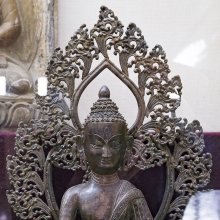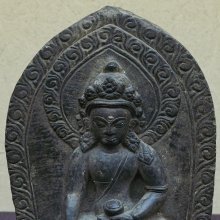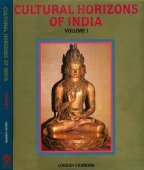Akshobhya, Akṣobhya: 18 definitions
Introduction:
Akshobhya means something in Buddhism, Pali, Hinduism, Sanskrit, Jainism, Prakrit, Marathi. If you want to know the exact meaning, history, etymology or English translation of this term then check out the descriptions on this page. Add your comment or reference to a book if you want to contribute to this summary article.
The Sanskrit term Akṣobhya can be transliterated into English as Aksobhya or Akshobhya, using the IAST transliteration scheme (?).
Images (photo gallery)
(+58 more images available)
In Hinduism
Shaktism (Shakta philosophy)
Source: Red Zambala: The 10 Great Wisdom GoddessesŚiva the lord of sleep, drank the halāhala poison, hence he is known as the Never- decaying (Akṣobhya).

Shakta (शाक्त, śākta) or Shaktism (śāktism) represents a tradition of Hinduism where the Goddess (Devi) is revered and worshipped. Shakta literature includes a range of scriptures, including various Agamas and Tantras, although its roots may be traced back to the Vedas.
In Buddhism
Tibetan Buddhism (Vajrayana or tantric Buddhism)
Source: Wisdom Library: MañjuśrīnāmasaṃgītiAkṣobhya (अक्षोभ्य) is one of the five Tathāgatas appearing in the Vajradhātu-mahāmaṇḍala, according to the Nāmamantrārthāvalokinī v5.30-32. The Nāmamantrārthāvalokinī (literally, ‘an explanation of the nāma-mantras’) is a commentary (ṭīkā) on the 8th century Mañjuśrīnāmasaṃgīti.
Akṣobhya is a name of Mañjuśrī (the embodiement of non-dual knowledge) and, together with other names, forms the core essence of the Mañjuśrīnāmasaṃgīti. The Nāmamantrārthāvalokinī provides the practitioner a sādhana (‘meditative practice’) to turn these names into mantras. These mantras are chanted for the benefit of all beings, and then placed and contemplated in the Vajradhātu-mahāmaṇḍala, which is an extended version of the Vajradhātu-maṇḍala.
Source: archive.org: The Indian Buddhist IconographyAkṣobhya (अक्षोभ्य) refers to one of the Dhyāni-Buddhas, according to Vajrayāna or Tantric Buddhism.—His Śakti, or female counterpart (spiritual consort) is named Māmakī and their Bodhisattva offspring is named Vajrapāṇi.—His colour is blue; his mudrā is the bhūsparśa; his vehicle is the elephant; and his symbol is the vajra.—Next in importance and antiquity is the Dhyāni Buddha Akṣobhya who is mentioned as a Tathagata in the smaller recension of the Amitāyus Sūtra which was translated into Chinese between A. D. 384 and 417. Akṣobhya is regarded as the Second Dhyāni Buddha by the Nepalese Buddhists. His description appears almost everywhere in Tantric literature.
1) Akṣobhya is described in the Pañcākāra section of the Advayavajrasaṃgraha thus:—“Akṣobhya originates from the blue syllable Hūṃ which is placed on the orb of the sun. He is two-armed and one-faced, exhibits the Bhūsparśa (earth-touching) mudrā and sits in the Vajraparyaṅka (adamantine seat) pose. He represents the primordial cosmic element of Vijñāna (consciousness). He is the embodiment of the Vajra-family and represents the winter season, noon-time, pungent taste, faculty of hearing, the element of Ether and Sound and the Ca (palatal) group of letters”.
2) The eight-armed variety of Akṣobhya has the colour blue and is the principal deity in the Akṣobhya-maṇḍala according to Piṇḍīkrama in the Niṣpannayogāvalī:—“Akṣobhya is blue in colour and is angry-looking. The colour of his right face is white and that of the left is red. He holds in his right hands the Vajra (family symbol), the discus and the lotus. In the three left hands he carries the bell, the Cintāmaṇi jewel and the sword. With the two principal hands he embraces the Prajñā Sparśavajrā by name”.
Source: WikiPedia: Tibetan BuddhismIn Vajrayana Buddhism, Akshobhya (Sanskrit for "Immovable One") is one of the Five Wisdom Buddhas, a product of the Adibuddha, who represents consciousness as an aspect of reality. His consort is Locana and he is normally accompanied by two elephants. His color is blue and his attributes include the bell, three robes, and staff, along with a jewel, lotus, prayer wheel, and sword. He has several emanations.
Source: academia.edu: The Structure and Meanings of the Heruka MaṇḍalaAkṣobhya (अक्षोभ्य) is the name of a Vīra (hero) who, together with the Ḍākinī named Akṣobhyī forms one of the 36 pairs situated in the Hṛdayacakra, according to the 10th century Ḍākārṇava chapter 15. Accordingly, the hṛdayacakra refers to one of the four divisions of the sahaja-puṭa (‘innate layer’), situated within the padma (lotus) in the middle of the Herukamaṇḍala. The 36 pairs of Ḍākinīs and Vīras [viz., Akṣobhya] are reddish yellow in color; they each have one face and four arms; they hold a skull bowl, a skull staff, a small drum, and a knife.
Source: OSU Press: Cakrasamvara SamadhiAkṣobhya (अक्ष्होभ्य) is the name of a deity [i.e., oṃ akṣobhyāya svāhā], according to the Guru Mandala Worship (maṇḍalārcana) ritual often performed in combination with the Cakrasaṃvara Samādhi, which refers to the primary pūjā and sādhanā practice of Newah Mahāyāna-Vajrayāna Buddhists in Nepal.—

Tibetan Buddhism includes schools such as Nyingma, Kadampa, Kagyu and Gelug. Their primary canon of literature is divided in two broad categories: The Kangyur, which consists of Buddha’s words, and the Tengyur, which includes commentaries from various sources. Esotericism and tantra techniques (vajrayāna) are collected indepently.
Mahayana (major branch of Buddhism)
Source: Wisdom Library: LokottaravādaAkṣobhya (अक्षोभ्य) is the name of a Buddha under whom Śākyamuni (or Gautama, ‘the historical Buddha’) acquired merit along the first through nine bhūmis, according to the Mahāvastu. There are in total ten bhūmis representing the ten stages of the Bodhisattva’s path towards enlightenment.
Akṣobhya is but one among the 500 Buddhas enumerated in the Mahāvastu during a conversation between Mahākātyāyana and Mahākāśyapa, both principle disciples of Gautama Buddha. The Mahāvastu is an important text of the Lokottaravāda school of buddhism, dating from the 2nd century BCE.

Mahayana (महायान, mahāyāna) is a major branch of Buddhism focusing on the path of a Bodhisattva (spiritual aspirants/ enlightened beings). Extant literature is vast and primarely composed in the Sanskrit language. There are many sūtras of which some of the earliest are the various Prajñāpāramitā sūtras.
General definition (in Buddhism)
Source: Wisdom Library: Dharma-samgrahaAkṣobhya (अक्षोभ्य) refers to “immovable Buddha” and represents one of the “five Buddhas” (pañcabuddha) as defined in the Dharma-saṃgraha (section 3). The Dharma-samgraha (Dharmasangraha) is an extensive glossary of Buddhist technical terms in Sanskrit (e.g., pañcabuddha and Akṣobhya). The work is attributed to Nagarguna who lived around the 2nd century A.D.
Source: Wisdom Library: BuddhismAkṣobhya (अक्षोभ्य) is the twentieth of sixty digits (decimal place) in an special enumeration system mentioned by Vasubandhu in his Abhidharmakośa (“treasury of knowledge”). The explanations of the measure of years, eons, and so forth must be comprehended through calculation based on a numerical system. Enumeration begins from one and increases by a factor of ten for each shift in decimal place. The sixtieth number in this series is called “countless”.
Among these decimal positions (e.g., akṣobhya), the first nine positions from one to one hundred million are called ‘single set enumeration’. From a billion up to, but not including countless is “the enumeration of the great companion” and is called the ‘recurring enumeration’.
In Jainism
General definition (in Jainism)
Source: archive.org: TrisastisalakapurusacaritraAkṣobhyā (अक्षोभ्या) is the name of a vidyā subdued by Rāvaṇa, according to the Jain Ramayana and chapter 7.1 [origin of the rākṣasavaṃśa and vānaravaṃśa] of Hemacandra’s 11th century Triṣaṣṭiśalākāpuruṣacaritra: an ancient Sanskrit epic poem narrating the history and legends of sixty-three illustrious persons in Jainism.
Accordingly, “[...] Rāvaṇa, knowing the highest good, not considering it worthless, remained motionless like a high mountain, absorbed in preeminent meditation. ‘Well done! Well done!’ was the cry of gods in the sky, and the Yakṣa-servants departed quickly, terrified. One thousand vidyās, the sky being lighted up by them, came to Daśāsya (=Rāvaṇa), saying aloud, ‘We are subject to you.’ [e.g., Akṣobhyā, ...] great vidyās beginning with these were subdued by noble Daśāsya in just a few days because of his former good acts. [...]”.

Jainism is an Indian religion of Dharma whose doctrine revolves around harmlessness (ahimsa) towards every living being. The two major branches (Digambara and Svetambara) of Jainism stimulate self-control (or, shramana, ‘self-reliance’) and spiritual development through a path of peace for the soul to progess to the ultimate goal.
Languages of India and abroad
Marathi-English dictionary
Source: DDSA: The Molesworth Marathi and English Dictionaryakṣōbhya (अक्षोभ्य).—a S Not to be excited, disturbed, ruffled--a mild disposition, deep water &c.
Marathi is an Indo-European language having over 70 million native speakers people in (predominantly) Maharashtra India. Marathi, like many other Indo-Aryan languages, evolved from early forms of Prakrit, which itself is a subset of Sanskrit, one of the most ancient languages of the world.
Sanskrit dictionary
Source: DDSA: The practical Sanskrit-English dictionaryAkṣobhya (अक्षोभ्य).—a. [kṣobhyate vicālyate; kṣubh-ṇic karmaṇi yat. na. ta.] Immovable, imperturbable; अक्षोभ्यः स नवोप्यासीत् (akṣobhyaḥ sa navopyāsīt) R.17. 44. was unassailable
-bhyaḥ 1 A particular sage (tantrokto dvitīyavidyopāsakaḥ taddevatāyāḥ śirasi nāgarūpeṇa sthitaḥ ṛṣibhedaḥ; akṣobhyosyā ṛṣiḥ proktaḥ -Tv.).
2) Name of a Buddha.
3) An immense number, said by Buddhists to be 1 विवर (vivara).
Source: Cologne Digital Sanskrit Dictionaries: Edgerton Buddhist Hybrid Sanskrit DictionaryAkṣobhya (अक्षोभ्य).—(1) m., name of a Buddha; the 2d of the 5 (‘transcendent’) Buddhas: Dharmasaṃgraha 3; Mahāvyutpatti 83; Sādhanamālā 16.9; (2) m., name of a Buddha dwelling in an eastern region: Saddharmapuṇḍarīka 184.7; Suvarṇabhāsottamasūtra 7.11; 120.5; Sukhāvatīvyūha 97.1; his lokadhātu is Abhirati, Saddharmapuṇḍarīka loc. cit., and (direction unspecified) Gaṇḍavyūha 82.9; Aṣṭasāhasrikā-prajñāpāramitā 366.14; see also Akṣobhyarāja; direction un- specified, in some cases at least doubtless the same person- age, Mahāvastu i.139.5; Suvarṇabhāsottamasūtra 152.15; Rāṣṭrapālaparipṛcchā 58.1; Śikṣāsamuccaya 14.13 ff.; see P. Mus, Barabudur, p. 578 ff.; (3) nt. (or m.), a high number (compare akṣobhiṇī): in Lalitavistara 147.22 = Mahāvyutpatti 7959, a hundred vivaras or viṃvaras; other, or unspecified, values Saddharmapuṇḍarīka 409.6; Mahāvyutpatti 8008 (here masc.); Sukhāvatīvyūha 31.1; (Ārya-)Mañjuśrīmūlakalpa 262.13.
Source: Cologne Digital Sanskrit Dictionaries: Monier-Williams Sanskrit-English Dictionary1) Akṣobhya (अक्षोभ्य):—[=a-kṣobhya] [from a-kṣobha] mfn. immovable, imperturbable
2) [v.s. ...] m. Name of a Buddha of an author, an immense number, said by Buddhists to be 100 vivaras.
3) Akṣobhyā (अक्षोभ्या):—[=a-kṣobhyā] [from a-kṣobhya > a-kṣobha] f. Name of a Yoginī, [Hemādri’s Caturvarga-cintāmaṇi]
Source: Cologne Digital Sanskrit Dictionaries: Goldstücker Sanskrit-English DictionaryAkṣobhya (अक्षोभ्य):—[tatpurusha compound] I. m. f. n.
(-bhyaḥ-bhyā-bhyam) Unshakeable, un-disturbable. Ii. m.
(-bhyaḥ) 1) The name of a Buddha.
2) An immense number, equal to 100 vivara, according to the Buddhists. E. a neg. and kṣobhya.
[Sanskrit to German]
Sanskrit, also spelled संस्कृतम् (saṃskṛtam), is an ancient language of India commonly seen as the grandmother of the Indo-European language family (even English!). Closely allied with Prakrit and Pali, Sanskrit is more exhaustive in both grammar and terms and has the most extensive collection of literature in the world, greatly surpassing its sister-languages Greek and Latin.
Kannada-English dictionary
Source: Alar: Kannada-English corpusAkṣōbhya (ಅಕ್ಷೋಭ್ಯ):—[adjective] not agitated; unperturbed; unmoved; firm.
Kannada is a Dravidian language (as opposed to the Indo-European language family) mainly spoken in the southwestern region of India.
See also (Relevant definitions)
Starts with: Akshobhyakavaca, Akshobhyakavacha, Akshobhyalamkrita, Akshobhyaraja, Akshobhyasamga, Akshobhyasamhitayamugratarasahasranama, Akshobhyatantre, Akshobhyatirtha, Akshobhyavajra.
Ends with: Mahakshobhya.
Full-text (+168): Akshobhyaraja, Nihkshobhya, Akshobhyakavaca, Five Dhyani Buddhas, Akshobha, Mahakshobhya, Ratnoccaya, Akshobhini, Abhirati, Immovable Buddha, Akshobhyasamga, Jnanadakini, Kshobhya, Dimbha, Ucchushmajambhala, Pitaprajnaparamita, Akshobhyalamkrita, Mamaki, Vasumatishri, Mahapratyangira.
Relevant text
Search found 33 books and stories containing Akshobhya, Akṣobhya, Akṣōbhya, Aksobhya, Akṣobhyā; (plurals include: Akshobhyas, Akṣobhyas, Akṣōbhyas, Aksobhyas, Akṣobhyās). You can also click to the full overview containing English textual excerpts. Below are direct links for the most relevant articles:
Stupas in Orissa (Study) (by Meenakshi Chauley)
Emanations of Aksobhya < [Chapter 5]
Buddha Images < [Chapter 5]
Major Stupas at Udayagiri < [Chapter 4]
Sripura (Archaeological Survey) (by Bikash Chandra Pradhan)
Scultures of Aksobhya < [Chapter 3 - Sculptural Programme]
Scultures of Maitreya < [Chapter 3 - Sculptural Programme]
Scultures of Manjughosa < [Chapter 3 - Sculptural Programme]
Vimalakirti Nirdesa Sutra (by Robert A. F. Thurman)
Maha Prajnaparamita Sastra (by Gelongma Karma Migme Chödrön)
Part 2 - Definition of Bodhisattva < [Chapter VIII - The Bodhisattvas]
Bodhisattva quality 10: patience relating to the profound dharmas < [Chapter X - The Qualities of the Bodhisattvas]
Guhyagarbha Tantra (with Commentary) (by Gyurme Dorje)
Text 1.5 (Commentary) < [Chapter 1 (text and commentary)]
Text 7.14 (Commentary) < [Chapter 7 (text and commentary)]
Text 8.3 (Commentary) < [Chapter 8 (text and commentary)]
The Indian Buddhist Iconography (by Benoytosh Bhattachacharyya)
Related products






